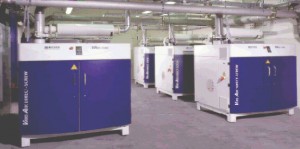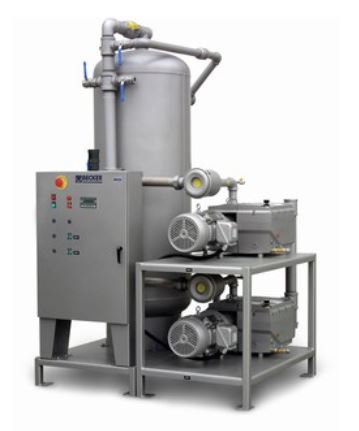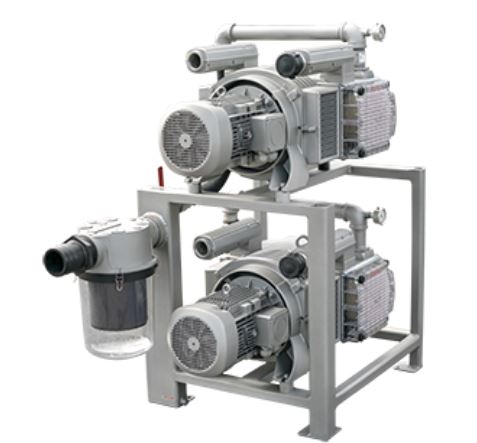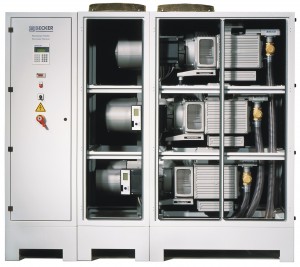Becker Systems & Equipment

VARIAIR Central System (VACS)
Central systems with a promise of success
The VARIAIR Central System (VACS) from Becker provides a compact solution for supplying air to one or more production systems. This method of supplying suction and blast air supply is employed in a wide range of different places.
Whether in small businesses or for specific stages of production in large companies, the energy-saving VARIAIR Central System delivers suction and blast air that’s matched to demand. VACS ideally complements subsequent finishing operations in printing shops equipped with the VARIAIR System (VAS), e.g. on assembling, folding and inserting machines, etc.
VACS is based on four different basic units with a wide range of accessories integrated in a cabinet. Of the modular design, these cabinets can be extended at any time to ensure flexibility in accommodating growing production requirements.
 VARIAIR Direct Screw (VADS)
VARIAIR Direct Screw (VADS)
VADS is the first direct-drive dry-running screw. With integrated speed controlling for demand-oriented applications and no need for a drive transmission, VADS is truly a Becker innovation!
This unit is able to fulfil the highest requirements for a wide range of applications. By entering the load and output into your customer system, the air supply system automatically and directly adapts to the given requirements. The frequency-controlled drive unit offers a wide control range with optimised demand matching. In addition to energy savings and higher efficiency, this also results in lower maintenance requirements. The non-contact, oil-free screw unit ensures high air flows with low pulsation and lends itself to “master/slave” operation. Integrated accessories include a non-return valve, intake filter, sound absorbers and ventilation/bleed system. An air blast cooler is also available.
The high-tech internal “workings” are reflected by the compact, modern design. All of the system components are integrated in an attractively designed, ready-to-use hood.
Configuration:
- Vacuum pump or compressor
- Direct-drive, no transmission required (see below)
- 100% oil-free compression
- 100% contact-free and non-wearing compression
- Integrated frequency converter
- Continuous output controlling
- Small oil circuit for synchronisation transmission
- Operating/ error messages shown in the display
Advantages:
- Compact unit, integrated accessories
- Low noise levels
- Lower maintenance requirements
- Pulsation-free air vacuum and blast air
- High degree of efficiency, low energy requirements
- Modern design
The spindle principle
Since 2012 Becker offers in addition to the successful VADS 1500 the smaller version VADS 250 as a vacuum pump with a spindle profile.
Another innovative Becker product, providing following advantages:
- Operates under a rough and fine vacuum level
- Large suction flow even at a high vacuum level
- Continous operation down to 1x 10-2 mbar
- VARIAIR Technology
- Integrated frequency inverter
- Air cooled
- Quick, simple installation and commissioning
- High efficiency
- Wear-free, dry compression
- Low operating cost
 Centralised Systems
Centralised Systems
Becker provides intelligent pneumatic solutions for one or several production machines.
In central pneumatic systems, multiple single pumps on separate production machines are replaced by just a few larger vacuum pumps and/or compressors in a separate room (control room, basement etc.). The units are connected to the production machines via pipes.
Central pneumatic systems provide your machines with on-demand vacuum and blast air, which means energy savings. Noise levels are drastically reduced in employee work areas.
Each pneumatic supply in a centralised system is equipped with its own frequency converter. Thus, the pneumatic requirements of each production machine can be continuously adapted for any given operating point. By average, frequency-controlled units operate at a relative speed of approx. 65%. Overall, this leads to significant energy savings over separate units and devices without speed controlling.
Our central pneumatic systems are always optimised for your specific requirements. Each system is designed and configured especially for the requirements of the given application.
Advantages:
No heat or noise emission in the production area
In production facilities, workplaces are being subjected to ever more stringent noise and heat emission regulations. In centralised pneumatic systems, there is no longer a need for separate vacuum pumps and compressors. Employees are subjected to minimum levels of heat, noise and oil mist.
Lower energy requirements for air conditioning systems
Eliminating the many separate pumps leads to a significant reduction in convection heat. Thus, air conditioning systems are subjected to lower loads and consume less energy. By removing the exhaust outlets (and the accompanying oil mist) from the production area, the air quality is greatly improved in the production area.
Energy savings using VACON controller
The central systems are controlled using the VACON controller. The VACON controller monitors and controls up to 4 different pressure or vacuum levels.
Central maintenance area
In centralised pneumatic systems, you can inspect and service the pneumatic supplies at a single location. It is much easier to access and inspect these units than to having to travel to each single supply unit for this purpose.
Lower maintenance requirements
Plants without a centralised pneumatic supply system typically have multiple vacuum pumps and compressors from multiple manufacturers in production. The many different replacements and wear parts required for each separate system results in drastically increased logistics and becomes expensive for the plant operator. Generally speaking, vacuum pumps and compressors in centralised pneumatic systems are low maintenance and utilise many of the same parts and materials. This restricts the range of required parts to an absolute minimum.
 Vacuum Systems
Vacuum Systems
Whenever a certain vacuum needs to be provided, vacuum systems from Becker are employed.
Systems for a continuous provisioning generally contain one or several vacuum pumps mounted on a vessel. This includes in the scope of delivery, in addition to connection hoses, also pressure switches, filters, vacuum meters and non-return flaps or valves.
The vacuum pumps to be used can be oil-free (VT 4.10 – VTLF 2.250) as well as oil-lubricated (U 4.20 – U 4.250) units. This makes it possible to achieve a vacuum of 90 % or otherwise 99.5 %. Side-channel vacuum pumps can also be employed for a lesser vacuum. Vessels are available in the sizes 90, 250, 500, 1000 and 2000 litre in horizontal versions. Upon request, they can be hot-dip galvanised inside and out.
For the automatic regulation of the vacuum level, the systems, which may also consist of a different number of vacuum pumps, can additionally be equipped with a control cabinet. It includes a transformer for power supply of the pressure switch, time relay, On-switch, main switch, operation and fault indicator as well as operating hours counter.
All systems have been designed so flexible that they can be equipped with additional accessories such as separators, ball valves, and so forth without a problem.
Beyond even larger oil-lubricated vacuum pumps, 2000 litre vessels can be used with centralised systems. In this case, pumps and vessel are set up separately.
example: 5x U 4.400, 2000L vessel + control cabinet
If vacuum provisioning has already been arranged for or is not required, the pumps may also be consolidated in a space-saving rack system. For instance, a medicine rack can be equipped with 3 oil-free vacuum pumps of the VTLF series (or KVT), secretion separators and control cabinet.
This way the highly flexible Becker vacuum system can always be optimally integrated with the customer application!
 Central Vacuum Systems
Central Vacuum Systems
Central vacuum systems are becoming increasingly more popular as manufacturers are looking for new ways to trim operating expenses and increase efficiency. Centralizing the vacuum needs eliminates the necessity for personnel to perform periodic maintenance or repair on many pumps around the facility.
It also permits continuous, uninterrupted operation because a central system usually includes a reserve, or back-up, pump that comes on stream automatically should a primary pump fail to operate.
Without a central system, should a pump fail or be down for maintenance, the machine associated with it would be out of service until another pump can be brought in and connected.
Centralizing also makes it more comfortable for the employees, an ever increasing concern in today’s business world. Removing pumps from the immediate work area reduces noise level and heat generated by the pumps and motors.
If the pumps were oil lubricated or water cooled, centralizing removes the potentially hazardous situation of oil or water on the floor, which might cause someone to slip, causing injury.
If you have questions about central vacuum pumps or positive displacement pumps, or you would like to know how this type of vacuum pump can work in your application, we can help. We offer five different vacuum pumps. Contact ABS for more information.
Central Vacuum Systems:
Advantage-D Oil-less Medical/Industrial Central Vacuum Systems
Advantage-D systems are 100% oil-less, dry central vacuum systems for medical/surgical or general industrial applications that require operating vacuum levels from atmosphere to as high as 27 in. Hg.
Advantage-P Auto-Purge Laboratory Vacuum Systems with Auto-Purge
Advantage-P laboratory central vacuum systems are a variation of our Advantage-L lubricated central systems with the inclusion of an Auto-Purge function. This enables the pumps to purge any remaining gases from the pump when shutting down, thus preventing corrosion and enhancing safety.
Advantage-L Oil-Flooded Medical/Industrial Central Vacuum Systems
Advantage-L models are compact central medical/industrial vacuum systems, able in most cases to fit through a 36” doorway.
Advantage-W Woodworking/CNC Router Systems
We specifically designed our Advantage-W industrial central vacuum systems to meet the requirements of manufacturers that use vacuum hold-down for router tables in the woodworking, thermoforming, and other related industries.
 Advantage-D Oil-less Medical/Industrial Central Vacuum Systems
Advantage-D Oil-less Medical/Industrial Central Vacuum Systems
Advantage-D systems are 100% oil-less, dry central vacuum systems for medical/surgical or general industrial applications that require operating vacuum levels from atmosphere to as high as 27 in. Hg.
Most models in this compact line can fill through 36” doorways. Other features include:
- Tank mounted or modular/expandable arrangements
- Field expandable up to six pumps
- Automatic alternating, cascading controls
- 18 to over 2600 CFM capacities
Our Advantage-D industrial central vacuum systems are most appropriate for applications that involve air or inert gases or moderate amounts of water vapor. Our medical/surgical systems meet current NFPA 99 requirements.
 Advantage-L Oil-Flooded Medical/Industrial Central Vacuum Systems
Advantage-L Oil-Flooded Medical/Industrial Central Vacuum Systems
Advantage-L models are compact central medical/industrial vacuum systems, able in most cases to fit through a 36” doorway.
Other features include:
- Tank mounted or modular/expandable arrangements
- Field expandable up to six pumps
- Automatic alternating and cascading controls
- 18 to over 2600 CFM capacities
Advantage-L systems employ our U-series oil-flooded pumps for those applications that require operation at higher vacuum levels, up to 29.83 in. Hg. (2.0 torr). These applications include medical/surgical, laboratory, material handling, and other industrial processes.
Our medical/industrial central vacuum systems are available NFPA 99 compliant for medical/surgical use.
 Advantage-P Auto-Purge Laboratory Vacuum Systems with Auto-Purge
Advantage-P Auto-Purge Laboratory Vacuum Systems with Auto-Purge
Advantage-P laboratory central vacuum pump systems are a variation of our Advantage-L lubricated central systems with the inclusion of an Auto-Purge function. This enables the pumps to purge any remaining gases from the pump when shutting down, thus preventing corrosion and enhancing safety.When a pump turns off, a timer is started and the main process line is isolated and fresh air (or an inert gas, if desired) is drawn into the pump for a period of time through a auxiliary port. When the timer is satisfied, the pump will stop operating.
All other features are identical to our Advantage-L central medical/industrial vacuum systems.
 Advantage-W Woodworking/CNC Router Systems
Advantage-W Woodworking/CNC Router Systems
We specifically designed our Advantage-W industrial central vacuum systems to meet the requirements of manufacturers that use vacuum hold-down for router tables in the woodworking, thermoforming, and other related industries.
Features include:
- 100% Oil-less/Dry operation
- Duplex and Triplex stacked arrangements
- Single inlet connection
- 130 to 1059 CFM capacity
- 7.5 to 72 HP
These industrial central vacuum systems also can be supplied with up to triple the normal inlet filtration to ensure clean air and long pump life and to minimize filter maintenance.

